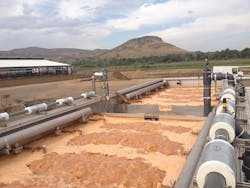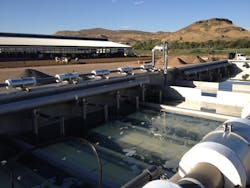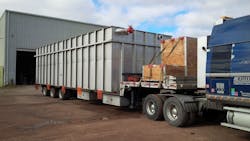Modular Membrane Bioreactor System Allows Yogurt Producer to Expand Operations
Noosa Yoghurt Co., named after an Australian town, produces a variety of yogurts in many flavors and sizes. Its production plant is located in a rural area in Bellvue, Colo.
When Noosa first began making yogurt, the plant was able to mix dairy wastewater with manure and apply it to land as a fertilizer. As production increased, this method of wastewater disposal became unsustainable, so Noosa made the environmentally responsible choice of investing in onsite wastewater treatment.
The company needed a reliable solution that would adapt to varying flows and wastewater characteristics, comply with strict environmental regulations, and generate an effluent suitable for onsite reuse or direct discharge.
The Solution
ADI Systems, an Evoqua brand, worked with a local engineering firm on the overall design of an aerobic membrane bioreactor (MBR) wastewater treatment system for Noosa. ADI supplied an equipment package consisting of prefabricated modular membrane tanks, pumps, scour blowers and instrumentation, which was integrated into the plant design.
This prefabricated membrane tank was selected because of its compact footprint, simple “plug-and-play” installation and proven ability to produce high-quality effluent. The physical membrane barrier provides a great deal of flexibility and stability in the biological process, as the MBR system can operate at higher mixed liquor suspended solids (MLSS) concentrations than conventional activated sludge systems. The MBR system’s long solids retention time and physical membranes work together to provide consistent removal of organics and nutrients.
The system was sized and designed with expansion in mind. As demand for Noosa products continued to increase, the company realized that wastewater production would quickly exceed original projections. The future design flow would be generated much sooner than expected, and the increase in permitted discharge flow meant that Noosa would need to meet stricter discharge limits on nitrogen and phosphorus. Noosa contacted ADI Systems to supply a second prefabricated membrane tank in order to double the treatment plant capacity, as well as evaluate the overall MBR system process design in order to achieve biological nutrient removal.
The Results
Noosa's state-of-the-art MBR produces a very high-quality effluent that allows the yogurt processor to comply with environmental regulations. The system ensures discharge limits on biochemical oxygen demand (BOD), total suspended solids (TSS), ammonia nitrogen (NH3-N), total nitrogen (TN), total phosphorus (TP), and fat, oil, and grease (FOG) are consistently met.
- BOD: < 30 mg/L (permitted), < 10 mg/L (operating results)
- TSS: < 30 mg/L (permitted), < 2 mg/L (operating results)
- NH3-N: < 15.7 mg/L
- TN: < 14.8 mg/L
- TP: < 1.7 mg/L
- FOG: < 10 mg/L
- pH range: 6.0 to 9.0
The MBR system also allows Noosa to make better use of water. The treated water is reused for cleaning cow barns and irrigating crops. Noosa’s commitment to environmental compliance is evidenced by its investment in responsible onsite wastewater treatment.


